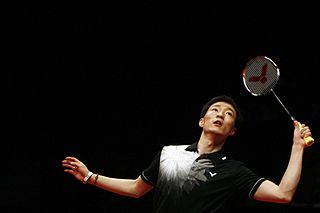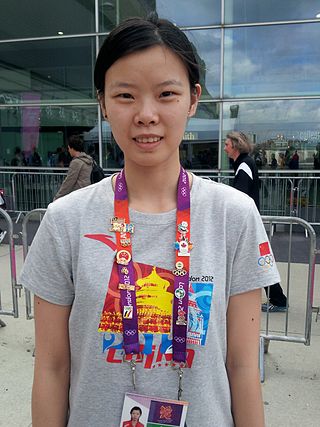Related Research Articles

Badminton is a racquet sport played using racquets to hit a shuttlecock across a net. Although it may be played with larger teams, the most common forms of the game are "singles" and "doubles". Badminton is often played as a casual outdoor activity in a yard or on a beach; formal games are played on a rectangular indoor court. Points are scored by striking the shuttlecock with the racquet and landing it within the opposing side's half of the court.

Table tennis, also known as ping-pong and whiff-whaff, is a racket sport derived from tennis but distinguished by its playing surface being atop a stationary table, rather than the court on which players stand. Either individually or in teams of two, players take alternating turns returning a light, hollow ball over the table's net onto the opposing half of the court using small rackets until they fail to do so, which results in a point for the opponent. Play is fast, requiring quick reaction and constant attention, and is characterized by an emphasis on spin relative to other ball sports, which can heavily affect the ball's trajectory.

Racquetball is a racquet sport and a team sport played with a hollow rubber ball on an indoor or outdoor court. Joseph Sobek invented the modern sport of racquetball in 1950, adding a stringed racquet to paddleball in order to increase velocity and control. Unlike most racquet sports, such as tennis and badminton, there is no net to hit the ball over, and, unlike squash, no tin to hit the ball above. Also, the court's walls, floor, and ceiling are legal playing surfaces, with the exception of court-specific designated hinders being out-of-bounds. Racquetball is played between various players on a team who try to bounce the ball with the racquet onto the ground so it hits the wall, so that an opposing team’s player cannot bounce it back to the wall.

Squash is a racket-and-ball sport played by two or four players in a four-walled court with a small, hollow, rubber ball. The players alternate in striking the ball with their rackets onto the playable surfaces of the four walls of the court. The objective of the game is to hit the ball in such a way that the opponent is not able to play a valid return. There are about 20 million people who play squash regularly world-wide in over 185 countries. The governing body of Squash, the World Squash Federation (WSF), is recognized by the International Olympic Committee (IOC), but the sport is not part of the Olympic Games, despite a number of applications. Supporters continue to lobby for its incorporation in a future Olympic program. The Professional Squash Association (PSA) organizes the pro tour.

Lee Hyun-il is a former badminton player from South Korea. He is a former World and Asian Championships bronze medalist, and was part of South Korean team that won the 2003 Sudirman Cup as well the gold medals at the 2002 and 2014 Asian Games.

Pickleball is an indoor or outdoor racket/paddle sport where two players (singles), or four players (doubles), hit a perforated hollow plastic ball over a 36-inch-high (0.91 m) net using solid-faced paddles. Opponents on either side of the net hit the ball back and forth until one side commits a rule infraction. Pickleball was invented in 1965 as a children's backyard game on Bainbridge Island, Washington, US. In 2022, pickleball was adopted as the official state sport of Washington.

The tennis scoring system is a standard widespread method for scoring tennis matches, including pick-up games. Some tennis matches are played as part of a tournament, which may have various categories, such as singles and doubles. The great majority are organised as a single-elimination tournament, with competitors being eliminated after a single loss, and the overall winner being the last competitor without a loss. Optimally, such tournaments have a number of competitors equal to a power of two in order to fully fill out a single elimination bracket. In many professional and top-level amateur events, the brackets are seeded according to a recognised ranking system, in order to keep the best players in the field from facing each other until as late in the tournament as possible; additionally, if byes are necessary because of a less-than-full bracket, those byes in the first round are usually given to the highest-seeded competitors.

Ball badminton is a sport native to India. It is a racket sport game, played with a yellow ball made of wool, on a court of fixed dimensions divided by a net. The game was played as early as 1856 by the royal family in Tanjore, the capital of Thanjavur district in Tamil Nadu, India. It enjoys the greatest popularity in India. Ball badminton is a fast-paced game; it demands skill, quick reflexes, good judgment, agility, and the ability to control the ball with one's wrist.

Saina Nehwal is an Indian professional badminton player. A former world no. 1, she has won 24 international titles, which includes ten Superseries titles. Although she reached the world's 2nd in 2009, it was only in 2015 that she was able to attain the world no. 1 ranking, thereby becoming the only female player from India and therafter the second Indian player – after Prakash Padukone – to achieve this feat. She has represented India three times in the Olympics, winning a bronze medal in her second appearance at London 2012.

Racketlon is a combination sport in which competitors play a sequence of the four most popular racket sports: table tennis, badminton, squash, and tennis. It originated in Finland and Sweden and was modeled on other combination sports like the triathlon and decathlon.

Maria Kristin Yulianti is an Indonesian badminton player. She is a bronze medalist in women's singles at the 2008 Olympics.

Ratchanok Intanon is a Thai badminton player who became the first Thai to become No.1 in women's singles. She is known for her relaxed hitting motion and light footwork, which has been described as 'balletic' by commentators such as Gillian Clark. She became the world champion in women's singles in 2013.

Tai Tzu-ying is a Taiwanese badminton player. At the age of 22, she became world No. 1 in the women's singles in December 2016, and she is the women's singles player who has held that title for the longest in BWF history, with 213 weeks. Tai was the women's singles silver medalist in the Tokyo 2020 Olympics and the gold medalist in 2017 Summer Universiade and at the 2018 Asian Games. She has won the year-end tournament BWF Superseries/World Tour Finals three times, and the All England Open thrice as of 2020. She has also won back-to-back Asian Championships titles.

Li Xuerui is a retired Chinese professional badminton player. She is one of the most successful players of her time. She was a gold medalist at 2012 London Olympics in the women's singles event and was the silver medalists in the 2013 and 2014 World Championships. Li Xuerui won fourteen Superseries titles, confirming her status as China's second most successful player after Wang Yihan. She reached a career high of no. 1 in the women's singles for 124 weeks. Li graduated with a BA from Huaqiao University.
Liew Daren is a Malaysian badminton player. His biggest success to date is having won the 2012 French Open Super Series. He reached a career high ranking of World No.10. He also represented Malaysia competed at the 2010 Guangzhou Asian Games and 2014 Glasgow Commonwealth Games.
The BWF World Ranking is the official ranking of the Badminton World Federation for badminton players who participate in tournaments sanctioned by Badminton World Federation. It is used to determine the qualification for the World Championships and Summer Olympic Games, as well as BWF World Tour tournaments. Seedings of draws at all BWF-sanctioned tournaments are conducted using the BWF World Ranking. Players under 19 years of age are eligible to rank in the BWF World Junior Ranking, which were introduced in January 2011. The following lists are the rankings:

Nozomi Okuhara is a Japanese badminton player. A former World's number 1 in the BWF rankings for the women's singles, she is well known for her speed, agility and endurance. She won a bronze at the 2016 Summer Olympics, and gold medal at the 2017 World Championships.
He Bingjiao is a Chinese badminton player. She began to receive intensive badminton training at the Suzhou Junior Sports School, when she was 7 years old. Five years later, she was sent to study in Nanjing and for tougher training there. The junior already competed in the senior level, and made her senior international debut at the 2013 Vietnam Open. In 2014, she competed at the Summer Youth Olympics, winning a gold medal in the girls' singles and a bronze in the mixed doubles event. She also won bronze medals at the World Championships in 2018 and 2021.
The 2014 New Zealand Open Grand Prix officially SkyCity New Zealand Open 2014 was a badminton tournament which took place at the North Shore Events Centre, Auckland, New Zealand from 15 until 19 April 2014 and had a total purse of $50,000.
The 2022 BWF World Tour Finals was the final tournament of the 2022 BWF World Tour. It was scheduled to be held from 14 to 18 December 2022 in Guangzhou, China but was later moved to Bangkok, Thailand, and held a week earlier – from 7 to 11 December 2022 – due to the COVID-19 pandemic in China. It had a total prize of $1,500,000.
References
- ↑ 1873 Muree-Simla Rules - 15 × 3 scoring system
- ↑ History of the Laws of the Badminton - 15 × 3 scoring system
- ↑ The Laws of the Badminton - 5 × 7 scoring system
- ↑ Scoring experiment ends at Games.
- ↑ Laws of Badminton at the Badminton World Federation website, accessed 17 October 2014
- ↑ Laws of Badminton at the Badminton World Federation website, accessed 10 March 2023
- ↑ Laws of Badminton at the Badminton World Federation website, accessed 10 March 2023
- ↑ "Scoring System". Bwfbadminton.org. Badminton World Federation. Retrieved 19 October 2014.
- ↑ "Events to Use Experimental Scoring System". Badminton World Federation. 1 July 2014. Retrieved 19 October 2014.